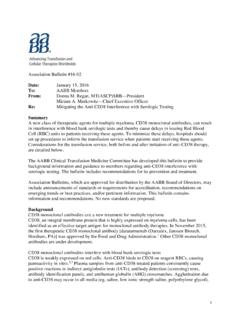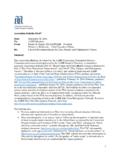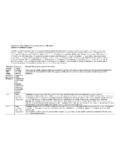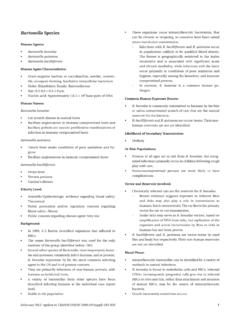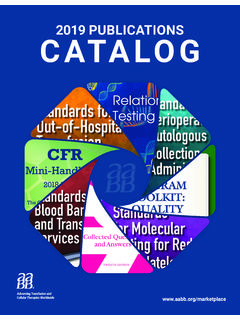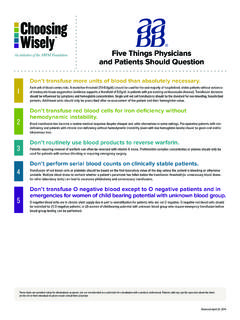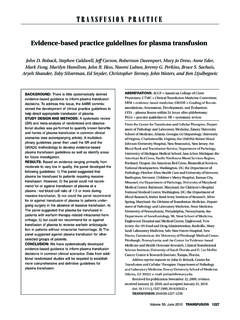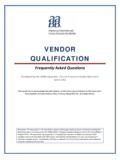Transcription of Antibody Identification: Art or Science?A Case …
1 Copyright 2013 by AABB. All rights identification : Art or Science?A case Study Approach(Questions and Answers)EditorsJanis R. Hamilton, MS, MT(ASCP)SBBS usan T. Johnson, MSTM, MT(ASCP)SBBS ally V. Rudmann, PhD, MT(ASCP)SBB iiCopyright 2013 by AABB. All rights of ContentsPreface .. iiiKey to Abbreviations and Interpretation of Reactions.. ivCase Study 1 .. 1 case Study 2 .. 5 case Study 3 .. 10 case Study 4 .. 14 case Study 5 .. 19 case Study 6 .. 25 case Study 7 .. 30 case Study 8 .. 36 case Study 9 .. 41 case Study 10 .. 46 case Study 11 .. 51 case Study 12 .. 57 case Study 13 .. 62 case Study 14 .. 67 case Study 15 .. 73 case Study 16 .. 80 case Study 17 .. 86 case Study 18 .. 92 case Study 19 .. 96 case Study 20 .. 103 case Study 21 .. 110 case Study 22 .. 118iiiCopyright 2013 by AABB.
2 All rights to Online SupplementAntibody identification and serologic problem solving involve much more than knowing how to perform the procedures. Once the mechanics of basic tests such as ABO/Rh type, direct and indirect antiglobulin tests, elutions, and adsorptions are learned, true mastery comes from understanding how and when to use the procedures to resolve unexpected reactivity in a patient s sample. This is why many say that Antibody identification is an art as well as a identification : art or science steps in where hands-on practice struggles to go. case studies that begin with a clinical scenario and initial test results guide the learner through a sequence of multiple choice questions that offer testing options and protocols for resolution. The difficulty of the cases ranges from basic to advanced, allowing use by multiple levels of students, residents, transfusion medicine fellows and practicing medical laboratory scientists (medical technolo-gists).
3 These cases are similar in that they address alloantibodies only. Autoantibodies or other situations involving positive autologous control tests or direct antiglobulin tests are not included. Advanced techniques for alloantibody identification such as the use of chemicals, inhibition, adsorption, and adsorption/elution are presented to challenge the learner who has mastered single alloantibody by practicing serologists and educators, the processes in these cases represent practical and efficient paths to problem resolution. Working through the cases will supplement didactic learning in a variety of settings from formal edu-cation programs to on-the-job instruction. Each case is designed as a stand-alone lesson enabling the instructor/supervisor to use just those cases most appropriate for their learner. Through cases that present serologic problem solving as a series of logical and systematic steps, the authors hope to demonstrate that the art of Antibody identification , as well as the science, can be a learned T.
4 Johnson, MSTM, MT(ASCP)SBB Sally V. Rudmann, PhD, MT(ASCP)SBB Jan Hamilton, MS, MT(ASCP)SBB ivCopyright 2013 by AABB. All rights to Abbreviations Reactive IgG-sensitized cellsACAutocontrolAHGA ntihuman globulinDATD irect antiglobulin testDTTD ithiothreitolEREmergency RoomHDFNH emolytic disease of the fetus and newbornIATI ndirect antiglobulin testISImmediate spinLISSLow ionic strength salineNHNo hemolysisPEGP olyethylene glycolRBCRed Blood Cell (unit)RTRoom temperatureSOPS tandard operating procedureSPSolid phaseInterpretation of Agglutination ReactionsMacroscopically Observed FindingsDesignationScoreOne solid agglutinate4+12 Several large agglutinates3+10 Medium-size agglutinates, clear background2+ 8 Small agglutinates, turbid background1+ 5 Very small agglutinates, turbid background1+w 4 Barely visible agglutination, turbid backgroundw+ or +/ 2No agglutination0 0 Mixtures of agglutinated and unagglutinated red cells (mixed field)mfComplete hemolysisHPartial hemolysis, some red cells remainPHUsed with permission from Roback JD, Grossman BJ, Harris T, Hillyer CD, eds.
5 Technical manual. 17th ed. Bethesda, MD: AABB, 2011 Study 1 2 case Study 1 Copyright 2013 by AABB. All rights Data:JP is a 58-year-old male with a history of cardiovascular disease for the past 10 years. He is scheduled for his second car-diac bypass surgery. For his first surgery, 7 years ago, he received 3 units of Red Blood Cells (RBCs) postoperatively. The transfusions were order for type and crossmatch of 4 RBC units has been received in preparation for this surgery. ABO and RH Typing:Forward (Cell) TypingReverse (Serum) Typing04+4+4+0 Antibody Detection Test (Screen): RHMNSLUPL ewisKellDuffyKiddGel Test++00+0++++0++ +0+++00++0++00+00+0++ 0+0++++ is JP s ABO type? is JP s RH type? +.. D+. determine with the data the results of the initial Antibody detection test, which of the following would be the MOST LIKELY interpretation of the patient s Antibody status?
6 Antibodies are present in the patient s The patient has one or more alloantibody(ies) or autoantibody(ies). patient has multiple patient has an autoantibody. Anti-AAnti-BAnti-DA1 CellsB CellsDCE c e fMNS s LuaLubP1 LeaLebKkFya FybJkaJkb IAT11+203 case Study 1 Copyright 2013 by AABB. All rights of the following Antibody specificities would be a likely hypothesis based on the results of the Antibody detection test and patient typing results? identification Panel:RHMNSLUPL ewisKellDuffyKiddGel Test++00+0++++0++0+0+0+++++00+0++++0+000 0++++++0++000+++0+0000+++0++00+++++0+0++ +00+000+0+0+++++0+0+++00++0+000++++++++0 ++0+0+0+++000++++++00+++0++0+0+000++++++ +0+00+0++0+0000++++0++0+++00+0+++000+++0 +0+0++0+0++00+++00+0++++0+0+0++0+++Labor atory Protocol:The following antibodies can be initially ruled out ONLY if the patient s serum is NOT reactive with the panel cells that have a double dose of the antigen: anti-C, -c, -E, -e, -M, -N, -S, -s, -Fya, -Fyb, -Jka, and antibodies listed on the antigen matrix can be initially ruled out if the patient s serum is NOT reactive with the panel cells that are positive for the corresponding antigen.
7 Keep in mind that weakly reactive antibodies may not be reactive with all antigen-positive any of the following antibodies are NOT ruled out using the initial screen and panel results, additional cells must be tested to provide data for rule-out decisions: anti-D, -C, -c, -E, -e, -M, -N, -S, -s, -Lea, -P1, -Leb, -K, -k, -Fya, -Fyb, -Jka, and Antibody specificity(ies) would explain ALL reactions observed in both the Antibody detection test and Antibody identification panel? and c e fMNS s LuaLubP1 LeaLebKkFya FybJkaJkb IAT 10 20 30 40 50 60 71+ 80 90 100 111+AC04 case Study 1 Copyright 2013 by AABB. All rights Antibody identification panel cell is the MOST appropriate to rule out anti-M? the combined results of the Antibody detection test and the Antibody identification panel, which of the following specificities was NOT ruled out?
8 Of the If this laboratory had a 3 + 3 rule for confirmation of Antibody specificity, how many additional cells must be tested to complete this identification ? Given the fact that 9% of the population is K+, approximately how many ABO-compatible units should be tested to identify three antigen-negative donor units? determine with the information Which crossmatch techniques should NOT be used with this sample? 37 C, LISS Study 2 6 case Study 2 Copyright 2013 by AABB. All rights Data:BH, a 62-year-old female, is scheduled for knee replacement surgery tomorrow. She has had several other surgeries, some requiring blood transfusion, but no procedures in the last 3 years. She has three sample was received in the blood bank with orders for type and crossmatch of 2 units of Red Blood Cells.
9 The following results were obtained in initial and RH Typing:Forward (Cell) TypingReverse (Serum) Typing04+4+3+0 Antibody Detection Test (Screen):RHMNSLUPL ewisKellDuffyKiddLISS(Test Tube)++00+0++++0+++0+++00++0++00+0+00++0 +0++++0000+++0+0+0+00+0+0+++ is BH s ABO type? is BH s RH type? +.. D+. determine with the data the results of the initial Antibody detection test (screen), which of the following would be the MOST likely interpretation of the patient s Antibody status? antibodies are present in the patient s The patient has one or more patient has one or more patient has an autoantibody with one or more underlying CellsB CellsDCE c e fMNS s LuaLubP1 LeaLebKkFya FybJkaJkbIS 37 C IAT1002+2001+3000 7 case Study 2 Copyright 2013 by AABB. All rights of the following antibodies COULD be ruled out using these initial Antibody detection test results?
10 Of the above could be ruled of the following procedures would be the BEST to perform next in this case ? the Antibody detection cells and include an autologous an immediate-spin an eluate from the patient s an Antibody identification identification Panel 1 (LISS Tube Method): RHMNSLUPL ewisKellDuffyKiddLISSDCEcefMNSsLuaLubP1 LeaLebKkFyaFybJkaJkbIS37 CIAT++00+0++++0++0+0+0+++002+++00+0+++00 +0000+++++002++0++000+++0+0000+++0+001++ 00+++++0+0+++00+000+000 0+0+++++0+0+++00++0+0002+00++++++++0++0+ 0+0+++000 000+++++0+0+++0++0+0+000 000+++++++0+00+0++0+0002+000++++0+00+++0 0+0+++000 000+++0+0+0++0+0++00+002+++00+0++++0+0+0 ++0+++002+000 Laboratory Protocol:The following antibodies can be initially ruled out ONLY if the patient s serum is NOT reactive with the panel cells that have a double dose of the antigen.
